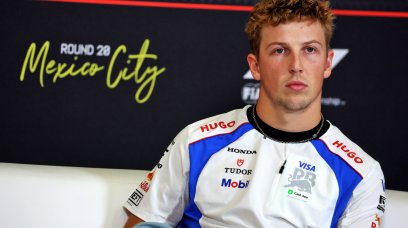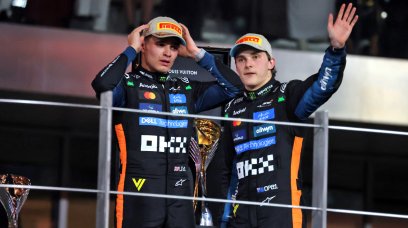As he celebrated his 32nd career Formula 1 victory and second from five races to start the 2013 season at the Spanish Grand Prix, the odds on this being Fernando Alonso's last for a decade must have been extraordinary.
This was a driver coming off the back of one of the most stunning driver seasons in the history of the World Championship as he dragged that dog of a 2012 car to within just four points of the most unlikely of titles.
It truly was anyone's game after Alonso's second victory at Barcelona as he moved reduced Sebastian Vettel's points lead over him from 30 to 17, with Kimi Raikkonen sandwiched in-between.
Another classic season was on the cards, but Alonso only scored six more podiums in the entire year, albeit four of these were in second place, all to Vettel as the German produced a crushing campaign to claim his fourth title.
After some years in the wilderness Alonso is back at the sharp end of Grand Prix racing, taking four podiums from five races in 2023, and was fourth in the other.
Aston Martin are firmly F1's second best team, with Alonso the prime candidate to sneak in and claim a victory should he produce something special or the Red Bulls trip up.
Win number 33 will have to wait a little longer, but let's go back a decade and remember win number 32, but first just what was going on in F1 2013?
What was F1 like in 2013?
This was a land reigned supreme by Bernie Ecclestone, where social media was anathema and if you'd proposed the idea of a behind-the-scenes Netflix documentary series, the look you would have received was enough to make an alien feel more welcome.
Lewis Hamilton was in his first season at Mercedes, Valtteri Bottas a rookie, Sergio Perez was in at McLaren and Max Verstappen, Charles Leclerc and George Russell were all aspiring racers with the hope of one day making it to Grand Prix racing.
It was the final season of the old naturally aspired three-litre V8 engines with the 1.6L V6 turbo hybrids set to be introduced for 2014 in a bid to make F1 more road relevant and attract new manufacturers in - which went well as even to this date, Honda were the only OEM to take up the offer, and then proceeded to struggle for half a decade. Fortunately, things look brighter for the 2026 engine rules reset.
But the biggest factor in F1 2013 was the Pirelli tyres.
This was perhaps the most extreme of the high degradation rubber they had been instructed to produce - with drivers often being told to drive to specific lap-times to just try and eke out their rubber to the next pit-stop as opposed to flat-out racing.
And it was causing problems.
Red Bull were feeling aggrieved as they felt the RB9 was being hampered by having to treat its tyres so carefully, while Raikkonen and Alonso had taken superb wins in Australia and China, respectively with Vettel having the honours in Malaysia - the multi-21 race - and in Bahrain.
Indeed, this point was given some credence as after the British Grand Prix failures, Pirelli returned to Kevlar belts in the rear tyres after switching to steel.
They also decided to mount the 2012 construction to the 2013 compounds at the Hungarian Grand Prix - with Vettel embarking on his famous winning run of nine straight wins after the summer break.
So what happened in Spain 2013?
Mercedes locked out the front-row with Nico Rosberg 0.017s up on Hamilton - but the Silver Arrows would not stay there.
The W04 had a ferocious appetite for lunching its rear tyres, which proved so in the race as Rosberg slipped to sixth while Hamilton was a lapped 12th. It would be his worst classified result until the 2021 Azerbaijan Grand Prix (15th place after that famous lock-up on the late restart).
At the start, from fifth place, Alonso put in a typically mighty start to leapfrog Raikkonen and, using KERS, drive around the outside of Hamilton at Turn 3.
Stopping on Lap 9 of 66, he undercut Vettel and then passed Rosberg on Lap 13 for the lead, crucially gaining some free air with which to put the hammer down, crucial as he would be making four stops to Raikkonen's three - the Lotus quickly emerging as the other contender - but stuck behind Vettel and Felipe Massa in the sister Ferrari...
The Finn eventually jumped both, but despite only pitting three times, Alonso was still 9.3s ahead at the flag.
Massa was third with Vettel fourth. In the remaining 14 races, the 2013 champion would win 11, take a second and third place in another two and retire from the other.
Rosberg managed a three-stopper but was over one minute behind with Jenson Button also pitting twice, but finished just two seconds ahead of the four-stopping Perez.
In total, 77 pit-stops were made in a race lasting 99 minutes.
As a post-script, Mercedes conducted a 'secret' tyre test with Rosberg and Hamilton at Barcelona for Pirelli.
In-season testing was banned at the time with the drivers wearing plain race suits and helmets, crucially in a 2013-spec car.
Pirelli argued as it was on safety grounds, extensive testing with a current car was allowed, but the FIA disagreed, having initially only believed 100km of running was to take place. As punishment Mercedes were banned from the Young Driver Test later in the year.
2013 Spanish Grand Prix results
| Position | Driver | Grid | Team | Points |
|---|---|---|---|---|
| 1st | Fernando Alonso | 5th | Ferrari | 25 |
| 2nd | Kimi Raikkonen | 4th | Lotus | 18 |
| 3rd | Felipe Masa | 9th | Ferrari | 15 |
| 4th | Sebastian Vettel | 3rd | Red Bull | 12 |
| 5th | Mark Webber | 7th | Red Bull | 10 |
| 6th | Nico Rosberg | 1st | Mercedes | 8 |
| 7th | Paul di Resta | 10th | Force India | 6 |
| 8th | Jenson Button | 14th | McLaren | 4 |
| 9th | Sergio Perez | 8th | McLaren | 2 |
| 10th | Daniel Ricciardo | 11th | Toro Rosso | 1 |
| 11th | Esteban Gutierrez | 19th | Sauber | 0 |
| 12th | Lewis Hamilton | 2nd | Mercedes | 0 |
| 13th | Adrian Sutil | 13th | Force India | 0 |
| 14th | Pastor Maldonado | 17th | Williams | 0 |
| 15th | Nico Hulkenberg | 15th | Sauber | 0 |
| 16th | Valtteri Bottas | 16th | Williams | 0 |
| 17th | Charles Pic | 22nd | Caterham | 0 |
| 18th | Jules Bianchi | 20th | Marussia | 0 |
| 19th | Max Chilton | 21st | Marussia | 0 |
| DNF | Jean-Eric Vergne | 12th | Toro Rosso | Collision |
| DNF | Giedo van der Garde | 18th | Caterham | Wheel |
| DNF | Romain Grosjean | 6th | Lotus | Suspension |
Can Alonso win again?
Since Alonso's last win, 13 drivers have claimed a Grand Prix victory, including first wins for Ricciardo, Verstappen, Bottas, Leclerc, Pierre Gasly, Perez and Esteban Ocon.
After the Miami Grand Prix which tipped him over the decade, it has been 201 races since he last stood on the top step, during which time he has 13 podiums and nearly two-and-a-half as many times retirements (33).
But Alonso still believes he is capable of delivering wins and, however improbable it may seem, that elusive third F1 crown he craves - that is why he is still racing as he approaches his 42nd birthday at a similar age where Raikkonen and Michael Schumacher both discovered the motivation draining away.
But where could that 33rd win actually come?
Although the AMR23 machine is an excellent package, it is draggy and so lacks the outright top-end speed of the Red Bull - which is multiple classes ahead of anyone else this season.
As such, Alonso has highlighted the slower, twistier circuits as an opportunity he is looking forward to.
Monaco is on the horizon, a race he has won twice, and his 2022 race there for Alpine was notable for him driving decidedly at his pace, holding up more than half the field behind him, with the two wins he has in Singapore make that another favourite.
Hungary is also circled, where he is set to celebrate 20 years since his maiden F1 victory in a race he lapped Schumacher's Ferrari.
He couldn't, could he?
Also interesting:
Balve Bains is joined by RacingNews365.com Editorial Director Dieter Rencken and Asia Correspondent Michael Butterworth to dissect the key talking points from the Miami Grand Prix.
Don't miss out on any of the Formula 1 action thanks to this handy 2026 F1 calendar that can be easily loaded into your smartphone or PC.
Download the calenderMost read
In this article













Join the conversation!